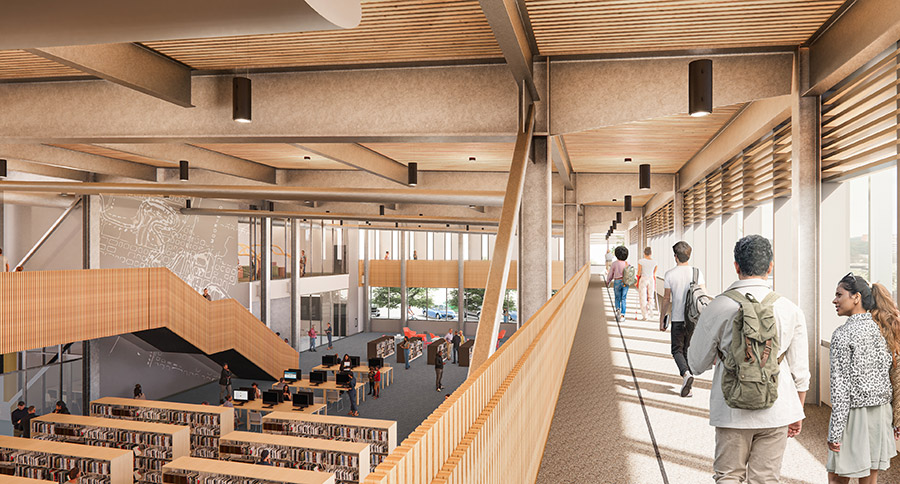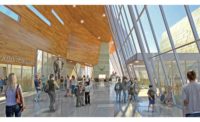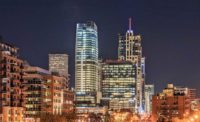JLG Chosen 2024 Colorado Design Firm of the Year

Augustana University’s $72-million, 154,000-sq-ft Midco Arena was designed by JLG Architects in collaboration with Clark Construction Group and Edgemoor Infrastructure & Real Estate.
Image courtesy JLG Architects
When last profiled as ENR Mountain States 2019 Design Firm of the Year for the Colorado, Wyoming and Dakotas area, JLG Architects was completing a decade-long shift from a generalist business strategy to one of specialized studios tailored to the region’s evolving needs.
Few could have predicted the upheaval that would soon follow as the pandemic affected lives, communities and the economy. Yet JLG managed not only to weather those challenges but also quickly return to growth.
The company, which was ranked No. 8 on the Colorado/Wyoming/Dakotas Top Design Firms list, reported $52.01 million in regional revenue for 2023. That was a nearly 20% increase over the previous year and just shy of doubling the level posted by the firm when it last received recognition from ENR.
[Neuro-diversity considerations have] “really elevated appreciation of the impact environments can have on employees’ well-being.”
—Michelle Allen, CEO, JLG
The keys to mitigating the pandemic’s effects, says CEO Michelle Allen, was staying close to clients and focusing on being a well-run business. Rather than risk losing people as revenue slowed, for example, JLG redeployed staff to functions such as business development, advancing and formalizing integrated design methodologies and building out platforms for project processes and customer relations.
“As projects came off hold and there was pent-up demand, we were really well positioned” Allen says. “There have been some really important projects we’ve been successful in landing because of all of this work we’ve done in the past three years.”
Examples include developing a 25-year master plan for Altru Health Systems’ Grand Forks, N.D., campus—a 157,486-sq-ft vision of a “Care Center in the Park” that embodies an environment of physical, emotional and spiritual healing—and a $37-million medical training facility at Williston State College that will begin construction in 2025.
Other JLG projects evidence the changing profile of the Dakotas’ current strong economy. They include designing AGCO’s 300-acre “smart farm” at Emerging Prairie's Grand Farm Innovation Campus in Casselton, N.D., aimed at helping develop autonomous technologies for agriculture.
With regional tourism also on the rise, JLG is leading a 12-firm consultant team for the new Theodore Roosevelt Presidential Library, currently under construction in Medora, N.D. And in Sioux Falls, S.D., JLG’s highly successful sports practice recently saw the grand opening of the $72-million, 154,000-sq-ft Midco Arena, home to Augustana University’s hockey team.

The Moorhead Community Center and Library combines traditional and interactive library programming with a second-story walking loop, a community “living room” and a Center for Entrepreneurship.
Image courtesy JLG Architects
Big-Picture Practices
Amid the accelerated adaptation to the pandemic’s effects, JLG remained committed to encouraging wide-scale adoption of sustainable, resilient and regenerative design wherever possible, albeit with an eye to achieving practical solutions that offer the greatest value.
“We try to be responsive to the demands of climate change and the demands of clients’ pocketbooks,” explains Dave Dimond, JLG’s director of design. “We think about performance with water and energy and the economic payback over a building’s life cycle.”
A similarly high-level focus for JLG is designing with consideration for neurodiversity—the different ways in which people perceive and respond to their environments in workspaces, public facilities and other settings. Allen stresses that neurodiversity considerations are particularly important in a tight labor market where both public- and private-sector clients are challenged with intense competition for talent.
“It has really elevated appreciation of the impact environments can have on employees’ well-being,” she says. “If they’re happy and thriving, your company will have a better path to achieving its outcomes, including retention.”
Dimond notes that recent expansions and renovations of JLG offices in Grand Forks, Sioux Falls and Bismarck, as well as the firm’s Minneapolis headquarters, have provided opportunities to “challenge ourselves to ‘live the story’ and test out our ideas.”
These elements have also come together in projects such as the Roosevelt Library, which aims to help visitors of all backgrounds experience and understand how the sparse, rugged environment of the grasslands outside the Little Missouri River floodplain helped shape the nation’s 26th president as a leader and a person and provided him with solace following the same-day deaths of his wife and mother.
“We’ve always put the design approach through the lens of the user,” says Jennifer Burke Jackson, leader of JLG’s commercial studio. “Thinking of the different environments that can challenge people also means recognizing those challenges can vary from one person to the next.”
Incorporating both building and landscape architecture, the library will offer what Burke Jackson calls “circles of experience” to provide visitors with customized ways to engage with the setting.
“The podcast set the stage for us to design spaces where we don’t have that firsthand experience.”
—Jennifer Burke Jackson, Commercial Studio Leader, JLG
These include a wheelchair-accessible rooftop where visitors can experience the Badlands visually, a three-quarter-mile pathway loop through the prairie and trails for hiking and mountain bike activities.
Burke Jackson notes that the library has evolved with the close collaboration of local residents and stakeholders.
“It’s about bringing the community into the solution, another trait Roosevelt embodied,” she adds.
A similar user-focused example is the Moorhead, Minn., Community Center and Public Library, a 70,000-sq-ft facility set to begin Phase 1 construction this summer.
Kristie Leshovsky, the city’s community development director, praises JLG and its library planning and design partner Miller Hull for ensuring all voices were heard for “the once-in-a-lifetime project.”
“We really wanted to make this building for the community, by the community,” Leshovsky says. “They’ve done a great job of working with all of the groups who we felt had to be involved in the process.”
Along with fine-tuning the design to bring the project cost more in line with budget projections, the project team’s innovation untangled a knotty problem with space programming by splitting library, community and activity spaces across the building’s two floors.
“We looked at their proposal and said, ‘Yeah, that’s it!’” Leshovsky recalls. “Understanding the different aspects of what the community wants and being able to put the best uses together will result in a really great building.”

Grand Farm will be a hub for autonomous technology aimed at accelerating agriculture through local and global partnerships, advanced training and development and onsite research and testing.
Image courtesy JLG Architects
Issues and Answers
JLG recently added a new dimension to its empathic design approach with the Heart River Women’s Transformation Center in Mandan, N.D.
Nearing the end of schematic design phase, the new minimum-security facility will support the North Dakota Dept. of Corrections and Rehabilitation’s efforts to address long-standing systemwide challenges residents face as they progress from incarceration into the community. Spaces and services focused on fostering positive relationships are intended to help residents be less vulnerable to influences that often cause them to “boomerang” back into the corrections system.
Many project design insights were gleaned from JLG’s Community Matters Podcast, a new initiative that draws on a variety of unique and sometimes overlooked perspectives to engage with communities and foster new ways of thinking on emerging topics.
The podcast’s first season, which focused on incarceration and its impact in rural America, offered viewpoints from all sides of the prison experience, including a Minnesota man who served a seven-and-a-half-year sentence.
“The podcast set the stage for us to design spaces in areas where we don’t have that firsthand experience,” Burke Jackson says. “All the different sides to the story are illuminating, and it’s been really powerful in helping us understand and support our clients as well as the people they serve and support.”
Colby Braun, NDDCR’s director, says JLG has captured the agency’s concept of a facility fully focused on healing, change and rehabilitation.
“They’re able to understand problems of people living and working in the unit and design in a pretty specific way,” he says. “The way they’ve put it into place is more than I expected.”
Braun points to the plan to house residents in apartments as an example.
“I don’t know if we’d gotten to that without the design workshops,” he says. “They took the time to listen to the staff and residents and got it into the design.”
As with their professional peers in other parts of the country, JLG’s leaders expect technology to play an increasingly prominent role in both project scope and processes.
“The potential of artificial intelligence in our firm and industry is incredibly rich,” Dimond says. “Drawings today are already multidimensional databases, so the idea of having more ways to manage this data will only make us better designers. It’s a future I’m excited about.”
Dimond adds that these powerful tools will also yield more human-centric, individualized designs that can help connect and reinvent communities, particularly those with limited resources.
“That’s always been on our mind at JLG,” he says.
As for the firm’s future, Allen says JLG intends to continue bringing deep expertise to the region while also positioning itself to be a strategic partner upstream of what has been traditionally considered for architects: for example, in assisting with complicated financing structures.
“We encourage employees to ask hard questions about what are we doing to position ourselves, staying attuned to what’s around us and doing the things necessary to sustainably grow,” she says, adding that it’s also important to preserve what has made JLG successful and exceptional.
And that goal, Allen says, “is to make a radical difference for our clients and our communities.”



